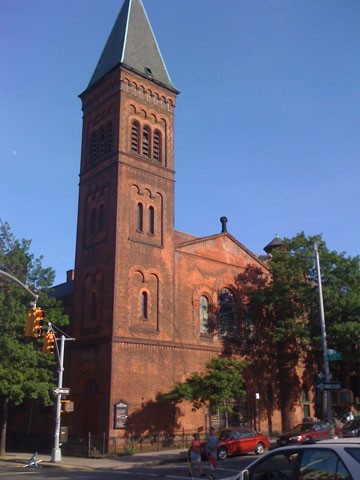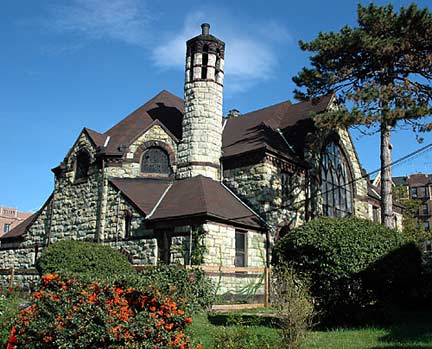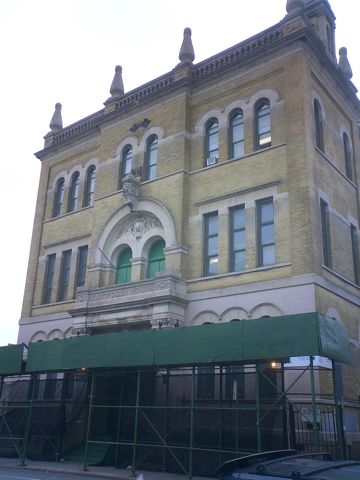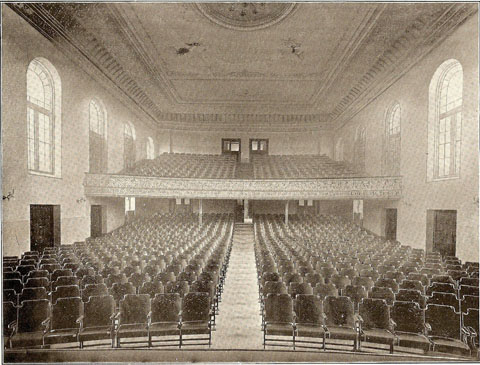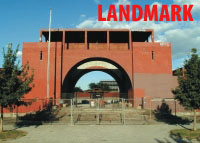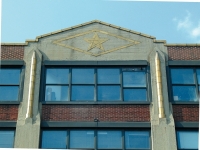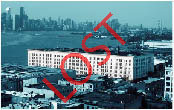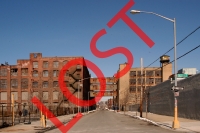Most Holy Trinity Church
Most Holy Trinity Church, Montrose Avenue
William Schickel, architect
Photo: Brooklyn Public Library
Gowanus Lounge had a post a week or two back about Holy Trinity Cemetery, a small German Catholic cemetery in Bushwick (next door to the larger Cemetery of the Evergreens). The cemetery was originally located behind Most Holy Trinity Church, in Williamsburg.
Now known as Most Holy Trinity and St. Mary*, the parish was originally founded as the German Church of the Holy Trinity in 1841. It was the first National parish in the Brooklyn diocese, and the first German Catholic Church in Williamsburg. It was also the mother church for a host of other German parishes over time. Holy Trinity was founded by Father John Raffeiner, a wealthy doctor-turned-priest from Austria. Raffeiner came to the United States in 1833, settling in New York where, in 1836, he founded St. Nicholas Church on East 2nd Street (the oldest German church in the New York Diocese). Raffeiner is also credited with establishing a German parish in Boston during this period. In 1841, Raffeiner moved to Williamsburg, a village that at the time was seeing a huge influx of German emigrés. There, largely with his own funds, the priest purchased property on Montrose Avenue from Abraham Meserole.
The first church of Most Holy Trinity was a frame structure, completed in 1841. A rectory was constructed in 1844. In 1853, the parish constructed a new church building on the corner of Montrose and Graham (it was for that church that the parish's cemetery was moved). Between 1863 and 1871, Holy Trinity's parish boundaries were divided numerous times - yielding Annunciation (1863), St. Nicholas (1865), All Saints (1867) and St. Leonard's (1872) parishes. Still, the original Holy Trinity parish continued to grow, and in 1880, construction began on a new church (on the site of the original frame church). The cornerstone for the new church was laid in 1882, and the building was completed in 1885. The new church was constructed of Belleville (N.J.) brownstone, with two towers of 250' each and a 70' tall nave (the spires, also constructed of brownstone, were covered in lead sheets in 1990).
The architect for the new church was William Schickel. Schickel was active in the late 19th century; he designed a number of churches and German-related structures in New York and Brooklyn. Among his more prominent works are the Century Building on Union Square (now home to a Barnes & Noble), the Freie Bibliothek und Lesehalle on Second Avenue (now the Ottendorfer branch of NYPL) and, next door, the German Poliklinik (now the Stuyvesant Polyclinic Hospital)
Betty Smith (née Elisabeth Wehner), author of "A Tree Grows in Brooklyn" was baptized at Holy Trinity in 1897. In her novel, the church is described as "the most beautiful in Brooklyn... it was made of old gray stone and had twin spires that rose cleanly into the sky, high above the tallest tenements".
The parish's property encompasses much of the block bounded by Graham, Johnson, Manhattan and Montrose. It includes the former Catholic Orphan Asylum on Graham Avenue (erected between 1865 and 1885), two school buildings, a rectory and a faculty residence. The rectory which appears to have been constructed in 1872 (Joseph Berendach, architect), is located immediately east of the church. The elementary school is located to the east of the rectory; constructed in 1888, it was, prior to its closing in 2005, the oldest parish school in Brooklyn. The high school, which closed in 1972, was located on Johnson Avenue. In the 1880s, the church's two schools enrolled 1,600 students. The faculty residence, at the corner of Montrose and Manhattan, was designed by Beatty and Berlenbach in 1952. In addition to the buildings on its block, Holy Trinity was responsible for the construction of the original St. Catherine's Hospital, on Bushwick and Devoe.
Most Holy Trinity & St. Mary Church is just one of many significant remnants of Williamsburg's German past. The building itself, together with its associated structures, is a landmark in every sense of the word. With the recent merger of Most Holy Trinity and St. Mary, MHT's might seem secure. But its roll of parishioners (now almost exclusively Hispanic) continues to dwindle, and most of its associated structures sit vacant. With any luck, the rectory, elementary school, asylum and faculty residence will find new and compatible uses.
*Most Holy Trinity merged with Immaculate Conception of the Blessed Virgin Mary Church in 2007. St. Mary's was founded in 1841 as an Irish church, and was located at Leonard and Maujer Streets.
Sources:
Most Holy Trinity - St. Mary: History
Most Holy Trinity - St. Mary: Tour of the Church
New York Architecture Images
BushwickBK - Bushwick Geographic: Most Holy Trinity Cemetery
Smith, Betty A Tree Grows in Brooklyn
"Five Years in Building: The New and Handsome Church for German Catholics in Williamsbug." New York Times, August 24, 1885, page 8.
100th Year Marked by Brooklyn Church." New York Times, October 13, 1941, page 12.
"Catholicism: A Significant Page of Local History." Brooklyn Daily Eagle, April 1, 1877, page 4.
"Local Improvements." Brooklyn Daily Eagle, July 26, 1872, page 3.
"A New Parochial School." Brooklyn Daily Eagle, May 14, 1888, page 6.
"Building Plans Filed." New York Times, June 23, 1952, page 32.
More photos after the jump...
